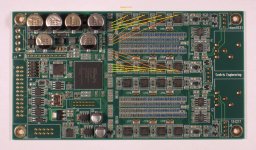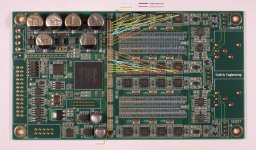@realAndreaMori
I am sure everyone here is eagerly awaiting you explaining the R2R DAC, seemingly a topic not yet researched nor published about anything 🙂
I am sure everyone here is eagerly awaiting you explaining the R2R DAC, seemingly a topic not yet researched nor published about anything 🙂
And I'm sure it will be a great Christmas gift for those like you who don't know how it works.
Now I understand the reasons why someone (RIP) was banned, he got tired.
Now I understand the reasons why someone (RIP) was banned, he got tired.
Last edited:
Which DAC do you think sound better and when did you hear it? In which system?
//
I would like to answer this question.
First of all, I generally reject DACs - with one exception (which does not matter here - because not DIY). I have so far spent a lot of time and energy for the implementation of a good PCM to PWM: Currently TAS5261. The basis for this could be heard at the time of a commercial Tact and Lyngdorf. These TI chips have great advantages and (still for some time...) some disadvantages if you want to perfect the concept. I myself, after many years of reminiscing about an old rebuilt tube CD player and an extremely good and extremely expensive amplifier, decided some time ago to look for a DAC that could do the D/A section better than TI as a prerequisite for a new approach. Then a well made tube in the low gain range. So a DAC with voltage output and a following tube stage after it. The latter should meet the requirements as a link between DA conversion and driver for an extremely powerful output stage. So power-wise something between buffer and 10V gain.
The Soekris concept would fit very well there. Multiple inputs, voltage output, R2R, NOS capability, etc. Personally, though, I don't want to bother with compromises. TI is a compromise for the time being. However, all the DACs I come across are also a compromise in terms of DA conversion. Then I prefer the advantages of the ultra-short paths of a TI!
In short, I'm looking for a concept from an ambitious competitor that goes in depth. I don't know why anyone would want to build a DAC that brings the same basic DA conversion issues as all other DACs. Better power supplies, output stages, etc., or not..
Funnily enough, I came across Andrea in this thread here, whose persistence is admirable. He is on fire for the cause. Acko, after all, has already said something here. But he is more verbally restrained. Without assessing exactly what Acko does, his brand of perfection is also consistent.
I'll have to keep looking before I start listening to a DAC that I then like to build on.
Good you are no longer talking of "4 points or maybe 8 points".
You make progress ... it is not that hard after all isn't it?
With some more "understanding on how a shift register and a sign-magnitude R2R DAC works" you will figure out the errors in your data protocol either, I am sure 😉
You make progress ... it is not that hard after all isn't it?
With some more "understanding on how a shift register and a sign-magnitude R2R DAC works" you will figure out the errors in your data protocol either, I am sure 😉
So where is the problem? Removing 36 resistors and cut 4 traces?
Maybe it's a problem for you but not for me.
BTW, you are not the designer and moreover you have already demonstrated that you don't know how this DAC works, since you claimed "there are many lines from the FPGA to the resistor ladder" while there are no lines between them.
This also means that you don't know how a shift register works, although the 595 is not properly a shift register since it provides a latch.
So, maybe better if I wait for the designer comment on the protocol.
Maybe it's a problem for you but not for me.
BTW, you are not the designer and moreover you have already demonstrated that you don't know how this DAC works, since you claimed "there are many lines from the FPGA to the resistor ladder" while there are no lines between them.
This also means that you don't know how a shift register works, although the 595 is not properly a shift register since it provides a latch.
So, maybe better if I wait for the designer comment on the protocol.
This level of modification should not be done by someone who can not figure out what he needs to do. You are on your own.
Moreover I need no lessons by someone who can not even distinguish a resistor from a capacitor.
Moreover I need no lessons by someone who can not even distinguish a resistor from a capacitor.
I think you talking of you, indeed it's not a job for those who don't know how it could work.
Well, I wrote 36 resistors but it's enough obvious that I meant 36 capacitors, and I have also to remove 16 resistor network and 4 single resistors used to shift the voltage level of signals used to feed the 595s that are bipolar powered.
I don't like this way because this means interference among the signals, I prefere optical isolation for the non crucial signals like BCK, DATA and rail enable, while the latch (the only crucial signal for this DAC) will come via copper directly divided from the master clock.
If you have not understood please let me know, I'm glad to explain again with easier words.
Well, I wrote 36 resistors but it's enough obvious that I meant 36 capacitors, and I have also to remove 16 resistor network and 4 single resistors used to shift the voltage level of signals used to feed the 595s that are bipolar powered.
I don't like this way because this means interference among the signals, I prefere optical isolation for the non crucial signals like BCK, DATA and rail enable, while the latch (the only crucial signal for this DAC) will come via copper directly divided from the master clock.
If you have not understood please let me know, I'm glad to explain again with easier words.
So everyone is already in the spirit of the season...
Andrea, wasn't it your intention to measure the phase noise / clocking behaviour of the DAM1021? If you take it apart now, will you still be able to do that?
Andrea, wasn't it your intention to measure the phase noise / clocking behaviour of the DAM1021? If you take it apart now, will you still be able to do that?
I will make the measurement before the tweaking.
Then I make the update, and if the sound will be improved I will provide a interface board to install a real FIFO for those who are not interested on watching movies.
Then I make the update, and if the sound will be improved I will provide a interface board to install a real FIFO for those who are not interested on watching movies.
Can I ask a beginner question?
What's the better way?
To regulate the volume via a potentiometer on the 1021 or in the power amplifier?
What's the better way?
To regulate the volume via a potentiometer on the 1021 or in the power amplifier?
I get out of your way
Since the designer does not help and some followers dislike my posts I have started a dedicated thread about the tweaking of the DAM1021 in order to install a true FIFO for those who owns the DAC and are not interested on watching movies
https://www.diyaudio.com/forums/dig...se-clock-soekris-dam1021-dac.html#post6460726
Have a nice Xmas and a happy new year
Andrea
Since the designer does not help and some followers dislike my posts I have started a dedicated thread about the tweaking of the DAM1021 in order to install a true FIFO for those who owns the DAC and are not interested on watching movies
https://www.diyaudio.com/forums/dig...se-clock-soekris-dam1021-dac.html#post6460726
Have a nice Xmas and a happy new year
Andrea
Can I ask a beginner question?
What's the better way?
To regulate the volume via a potentiometer on the 1021 or in the power amplifier?
Via the digital control.
btw watching video is not necessarily out of the question with a long delay FIFO, video player softwares can set video delay.
Can I ask a beginner question?
What's the better way?
To regulate the volume via a potentiometer on the 1021 or in the power amplifier?
Best is to do both. To reduce gain of amplifier so that 0 dB of DAC is slighty higher than max volume required and do the volume control via DAC digital control. Reduction of amp gain can best be done by modification of gain registers in input stage.
Thanks, that's how I'll do it.
It will be an L20.5 amplifier that is currently under construction.
I will adjust the input gain on him
It will be an L20.5 amplifier that is currently under construction.
I will adjust the input gain on him
Last edited:
- Home
- Vendor's Bazaar
- Reference DAC Module - Discrete R-2R Sign Magnitude 24 bit 384 KHz


